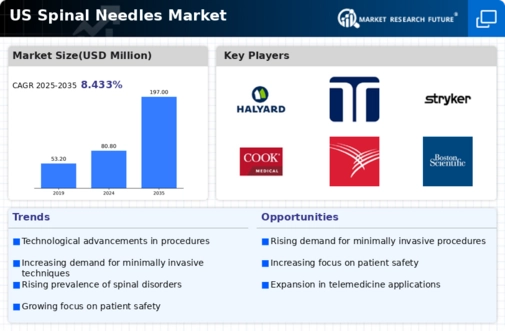Growing Geriatric Population
The aging population in the US is a significant factor influencing the spinal needles market. As individuals age, they are more susceptible to spinal conditions, necessitating various medical interventions. The US Census Bureau projects that by 2030, approximately 20% of the population will be aged 65 and older. This demographic shift is likely to increase the demand for spinal procedures, including epidural injections and spinal anesthesia, which rely on spinal needles. Consequently, the spinal needles market is expected to expand as healthcare providers cater to the needs of this growing population segment, highlighting the importance of spinal needles in geriatric care.
Rising Healthcare Expenditure
Increased healthcare spending in the US is another driver for the spinal needles market. As healthcare budgets expand, hospitals and clinics are investing more in advanced medical equipment and technologies. The Centers for Medicare & Medicaid Services (CMS) reported that national health expenditure is projected to grow at an average rate of 5.4% annually, reaching nearly $6 trillion by 2027. This financial commitment to healthcare infrastructure is likely to enhance the availability and quality of spinal procedures, thereby increasing the demand for spinal needles. As healthcare facilities upgrade their equipment, the spinal needles market stands to benefit from this upward trend in healthcare expenditure.
Advancements in Medical Technology
Technological innovations in the medical field are significantly impacting the spinal needles market. The introduction of advanced needle designs, such as pencil-point and atraumatic needles, enhances patient safety and comfort during procedures. Furthermore, the integration of imaging technologies, such as ultrasound and fluoroscopy, allows for more precise needle placement, reducing complications. The market for spinal needles is projected to grow at a CAGR of around 6% over the next few years, driven by these advancements. As healthcare facilities adopt these new technologies, the demand for high-quality spinal needles is expected to increase, thereby benefiting the spinal needles market.
Increasing Prevalence of Spinal Disorders
The rising incidence of spinal disorders in the US is a crucial driver for the spinal needles market. Conditions such as herniated discs, spinal stenosis, and degenerative disc disease are becoming more common, leading to a higher demand for diagnostic and therapeutic procedures. According to recent data, approximately 80% of adults experience back pain at some point in their lives, which often necessitates spinal interventions. This growing patient population is likely to propel the spinal needles market, as healthcare providers seek effective solutions for pain management and surgical procedures. The increasing prevalence of these disorders suggests a sustained need for spinal needles, thereby driving market growth.
Enhanced Training and Education for Healthcare Professionals
The emphasis on improved training and education for healthcare professionals is a notable driver of the spinal needles market. As medical education evolves, practitioners are becoming more skilled in performing spinal procedures, which increases the utilization of spinal needles. Training programs that focus on the latest techniques and technologies are being implemented across various medical institutions. This enhanced proficiency among healthcare providers is likely to lead to a higher volume of spinal interventions, thereby driving demand for spinal needles. The ongoing commitment to professional development in the medical field suggests a positive outlook for the spinal needles market.




















Leave a Comment